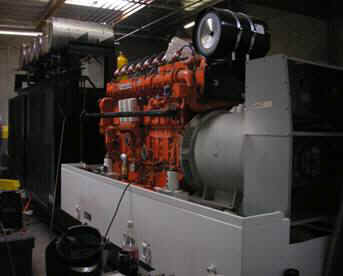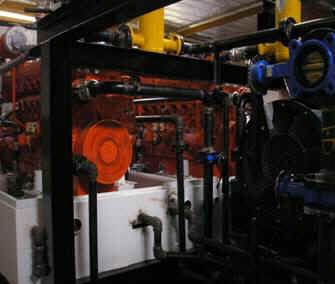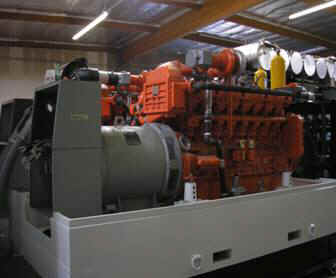|
CHP Conference Platinum Sponsorship Available
#CHPconference_ |
|
CHP Conference Platinum Sponsorship Available
#CHPconference_ |
CHP
Conference
www.CHPconference.com
What are CHP Systems?
A CHP System - also known as a cogeneration plant, is the simultaneous production of power and thermal energy.
Stated another way, a CHP System integrates an onsite, "decentralized energy" (DE) or "dispersed generation" power and energy system with thermally-activated power and energy technologies such waste heat recovery and/or absorption chillers for heating and/or cooling applications.
CHP Systems are also at the center of every District Energy System and significantly reduce:
energy costs
fuel costs
CHP
Systems achieve these greater energy efficiencies
through the conversion of exhaust or reject heat from power generation into
needed energy services like cooling and heating of buildings as well as
campuses. This is called "Waste
Heat Recovery" or "Recycled
Energy." Development of "packaged" or
"modularized" CHP
Systems for end-use applications, such as commercial and
institutional buildings, is something the founder of our company has been
involved with since the mid 1980's.
In the past, Cogeneration
plants have been economically attractive only in sizes above several megawatts.
The emergence of a number of small generation technologies, including fuel
cells, advanced low emissions engines, and gas
turbines with outputs in the 1000 kW - 5000 kW range, should extend
the benefits of Integrated
Energy Systems to a much larger user base, with a consequent increase
in national energy and environmental benefits.
For example, the application of CHP Systems (including Absorption Chillers - or - ADsorption Chillers) in commercial buildings could reduce commercial building energy consumption by 30%.
Application
of such smaller-scale packaged CHP
Systems provides a major breakthrough in energy efficiency
technology, energy savings as well as reduced greenhouse
gas emissions. And, by locating
the power generation at or near the end-user/consumer, i.e. their facility,
building, or campus, the difficulties in siting and building new electric
transmission and electric distribution infrastructures to meet today's
increasing power demand are minimized.
There are numerous markets for Cogeneration
/ Trigeneration
plants, CHP Systems,
District
Energy Systems or Integrated
Energy Systems are commercial or institutional buildings, government
facilities, and district energy systems that distribute thermal energy to
buildings in a college campus, hospital complex, industrial park, food
processing operations, refrigerated warehouses, and also very attractive for
cities.
Clean Power Generation Solutions
CHP
Systems (Cogeneration
and Trigeneration)
Plants
Have Very High Efficiencies, Low Fuel Costs & Low Emissions
The CHP System
below is Rated at 900 kW and Features:
(2) Natural Gas Engines @ 450 kW each on one Skid with Optional
Selective Catalytic Reduction system that removes Nitrogen
Oxides to "non-detect."
The Effective Heat Rate for the CHP System
below is
4100 btu/kW & the overall system efficiency is 92%.



CHP Systems may be the best solution for your company's economic and environmental sustainability as we "upgrade" natural gas to clean power with our clean power generation solutions.
Our Emissions Abatement solutions reduce Nitrogen Oxides to "non-detect" which means our Trigeneration energy systems can be installed and operated in most EPA non-attainment regions!
|
|
What is "Decentralized Energy"?
Decentralized Energy is the opposite of "centralized energy." Decentralized Energy energy generates the power and energy that a residential, commercial or industrial customer needs, onsite. Examples of decentralized energy production are solar energy systems and solar trigeneration energy systems.
Today's electric utility industry was "born" in the 1930's, when fossil fuel prices were cheap, and the cost of wheeling the electricity via transmission power lines, was also cheap. "Central" power plants could be located hundreds of miles from the load centers, or cities, where the electricity was needed. These extreme inefficiencies and cheap fossil fuel prices have added a considerable economic and environmental burden to the consumers and the planet.
Centralized energy is found in the form of electric utility companies that generate power from "central" power plants. Central power plants are highly inefficient, averaging only 33% net system efficiency. This means that the power coming to your home or business - including the line losses and transmission inefficiencies of moving the power - has lost 75% to as much as 80% energy it started with at the "central" power plant. These losses and inefficiencies translate into significantly increased energy expenses by the residential and commercial consumers.
Decentralized Energy
is the Best Way to Generate Clean and Green Energy!
How we make and distribute electricity is changing!
The electric power generation, transmission and distribution system (the electric "grid") is changing and evolving from the electric grid of the 19th and 20th centuries, which was inefficient, highly-polluting, very expensive and “dumb.”
The "old" way of generating and distributing energy resembles this slide:
The electric grid of the 21st century (see slide below) will be Decentralized, Smart, Efficient and provide "carbon free energy" and “pollution free power” to customers who remain on the electric grid.
Some customers will choose to dis-connect from the grid entirely. (Electric grid represented by the small light blue circles in the slide below.)
Typical
"central" power plants and the electric utility companies
that own them will either be shut-down, closed or go out of business due
to one or more of the following: failed business model, inordinate
expenses related to central power plants that are inefficient, excessive
pollution/emissions, high costs, continued reliance on the use of fossil
fuels to generate energy, and the failure to provide efficient, carbon
free energy and pollution free
power.
Carbon free energy and pollution free power reduces our dependence on foreign oil and makes us Energy Independent while reducing and eliminating Greenhouse Gas Emissions.
* Some of the above information from the Department of Energy website with permission.
Battery Energy Storage * Bulk Energy Storage * CHP Systems * Cogeneration * Demand Side Management
Distributed Energy Resources * EcoGeneration * Micro-Grid * Peak Shifting * Waste Heat Recovery
We support the Renewable Energy Institute and the American Energy Plan by donating a portion of our profits to the Renewable Energy Institute in their efforts to reduce fossil fuel use through renewable energy and their goals to end fossil fuel pollution by reducing/eliminating Carbon Emissions, Carbon Dioxide Emissions and Greenhouse Gas Emissions.
The Renewable Energy Institute is "Changing The Way The World Makes and Uses Energy by Providing Research & Development, Funding and Resources That Creates Sustainable Energy via 'Carbon Free Energy,' 'Clean Power Generation' and 'Pollution Free Power' Through Expanding the use of Renewable Energy Technologies."

![]()
www.RenewableEnergyInstitute.org
Email: info(@)Renewable Energy Institute (.)org
The information contained on this site is
copyright protected and
cannot be
reproduced in any form or manner without our consent.
CHP
Conference
www.CHPconference.com
![]()
Renewable Energy Institute
Copyright
© 2003
All Rights Reserved